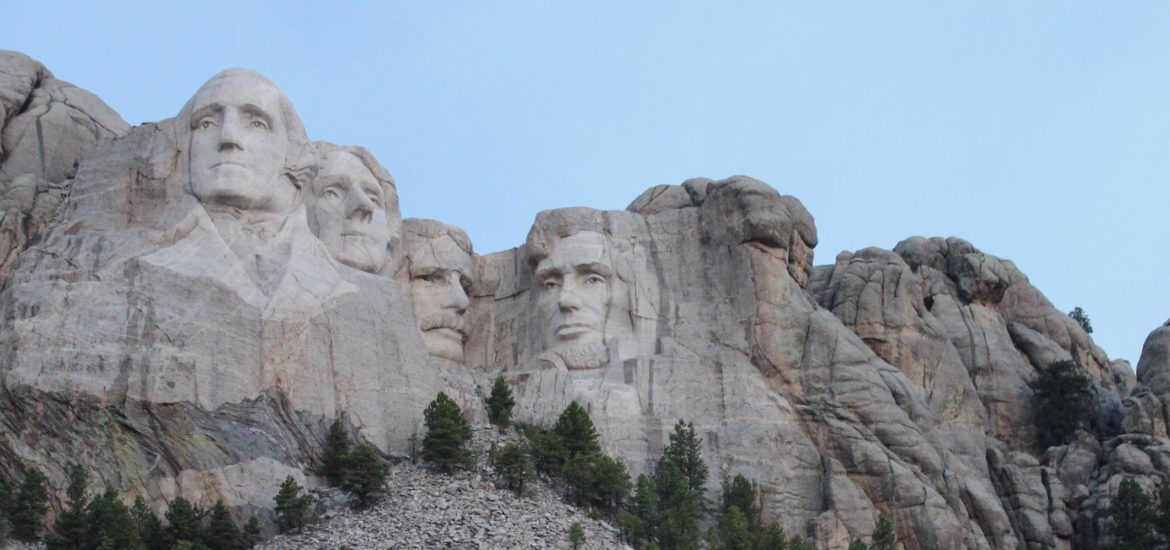On Tuesday, we woke up at the Badlands Inn and started our morning with the free continental breakfast. By 8:00am, we were checked out and made our way over to the Minuteman Missile Site, which is just north of Badlands National Park – and on our way out of the area as we would make our way over to Mount Rushmore later in the morning.
 But first, we stopped into the visitor’s center for the Minuteman Missile Site and took a look at some of the exhibits that told the story of how many nuclear warheads the United States and the USSR had pointed at each other throughout the Cold War. The numbers are mind boggling. The museum exhibits conclude by showing you how many nuclear weapons have been eliminated from both of these great superpowers since the Cold War ended, but also how a few other nations also have their own missiles now. They include England, Israel, Pakistan, India, China, and North Korea. Hopefully one day, the world will rid itself of these weapons. For now, they remain in a defense posture by the United States and all these other nations. But the threat of human extinction – by our own hands – remains almost as great a threat today, as long as nuclear weapons remain in existence.
But first, we stopped into the visitor’s center for the Minuteman Missile Site and took a look at some of the exhibits that told the story of how many nuclear warheads the United States and the USSR had pointed at each other throughout the Cold War. The numbers are mind boggling. The museum exhibits conclude by showing you how many nuclear weapons have been eliminated from both of these great superpowers since the Cold War ended, but also how a few other nations also have their own missiles now. They include England, Israel, Pakistan, India, China, and North Korea. Hopefully one day, the world will rid itself of these weapons. For now, they remain in a defense posture by the United States and all these other nations. But the threat of human extinction – by our own hands – remains almost as great a threat today, as long as nuclear weapons remain in existence.
 As we departed the visitors center, the rangers there told us that if we were headed in the westward direction (which we were) we should stop at the D-09 Minuteman Missile site. It’s about 15 miles or so to the west of the visitor’s center. Between 9am and 10am there would be a park ranger out there to tell us more about the site and let us into the gate. When we got there, it was exactly 9:00 AM and there were about 10 other people waiting by their cars, for the park ranger to arrive. He was about 10 or 15 minutes late. “If we were 10 or 15 minutes late to this site during the Cold War,” I told Marshall, “we might have lost.” We chuckled.
As we departed the visitors center, the rangers there told us that if we were headed in the westward direction (which we were) we should stop at the D-09 Minuteman Missile site. It’s about 15 miles or so to the west of the visitor’s center. Between 9am and 10am there would be a park ranger out there to tell us more about the site and let us into the gate. When we got there, it was exactly 9:00 AM and there were about 10 other people waiting by their cars, for the park ranger to arrive. He was about 10 or 15 minutes late. “If we were 10 or 15 minutes late to this site during the Cold War,” I told Marshall, “we might have lost.” We chuckled.
This site is less than a mile from the Interstate 90 exit. There was a free audio guide that can be listened to via your phone. One of the things it said was to take a look back at all the cars just passing by this site less than a mile away on I-90. To think, here, hidden in the ground was a nuclear warhead, ready to make a strike on the USSR if need be. And on a daily basis, thousands of vehicles were less than a mile away from this site. There were over 450 of these nuclear missiles hidden in the ground throughout the Midwest and there are still many active ones today.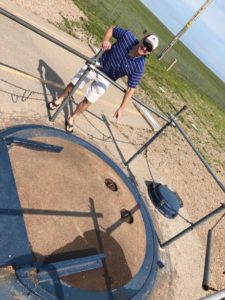
When the ranger arrived (a few minutes after we did), he opened the gate and let us look down into the launch pad. Through the glass, we could see a Minuteman Missile. Wow! He explained to us how this missile was just surrounded by the same fence it is today, and how it was monitored by a central command, with computers checking in on it every minute or so, making sure it was secure, but also ready to go at a moment’s notice. Some of the reasons that these sites are where they are out here in South Dakota and other nearby states are because there is a much lower population around here, then say New York or Los Angeles. But they are also located here because, geographically, the Dakotas are much closer to the USSR and the strikes could be quicker, if necessary.
Coming out to this site on Independence Day week made me more grateful that we won not only the Revolutionary War, but also the Cold War, and that we did so without these missiles ever being needed to be fired. However, the visit here also showed me the lengths we were willing to go to defend a free people against the threat of Soviet communism. More than anything, seeing this missile here and the purpose of it, really made the Cold War that much more real for me. I mean, holy crap; a nuclear warhead right here under the ground, ready to go at a moment’s notice. The Soviet threat and a potential nuclear exchange with them was seriously real. We shouldn’t take that for granted.
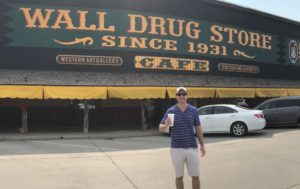 I saw a young kid here, probably about eight years old, looking down at the missile under the glass in the ground. I was thinking how he never had to think about the Cold War or Soviet communism in his time. Does this all just look like ancient history to him? How real is another threat in our lifetime? Let’s hope these missiles don’t ever have to be fired.
I saw a young kid here, probably about eight years old, looking down at the missile under the glass in the ground. I was thinking how he never had to think about the Cold War or Soviet communism in his time. Does this all just look like ancient history to him? How real is another threat in our lifetime? Let’s hope these missiles don’t ever have to be fired.
After visiting this site, we pioneered on back into the city of Wall, South Dakota, just a few miles up the road. We stopped at the famous Wall Drug store. A few days ago, I don’t think I had heard of it. But today, I thought it was famous. We must have seen dozens of roadside signs advertising the many things in this great big department store, which basically had stores within it almost like a mini-mall. However, I came for the well-advertised 5-cent cup of coffee. But if you wanted a large one to go, it was 75 cents. Of course, I upgraded to the 75-cent one. After a quick stop there, we got back on the road towards Mount Rushmore, which was about a 75-minute drive from there.
We passed through the big city – Rapid City – and about twenty minutes or so later, arrived at Mount Rushmore. “Whoever can spot it first, gets a free beer,” I said to Marshall. I won. But we both won. It was amazing at first sight. We waited about 10 minutes to get into the parking area, which was $10. However, that parking pass is good for one year. So, if I want to come back in six months…scratch that, it will be cold.
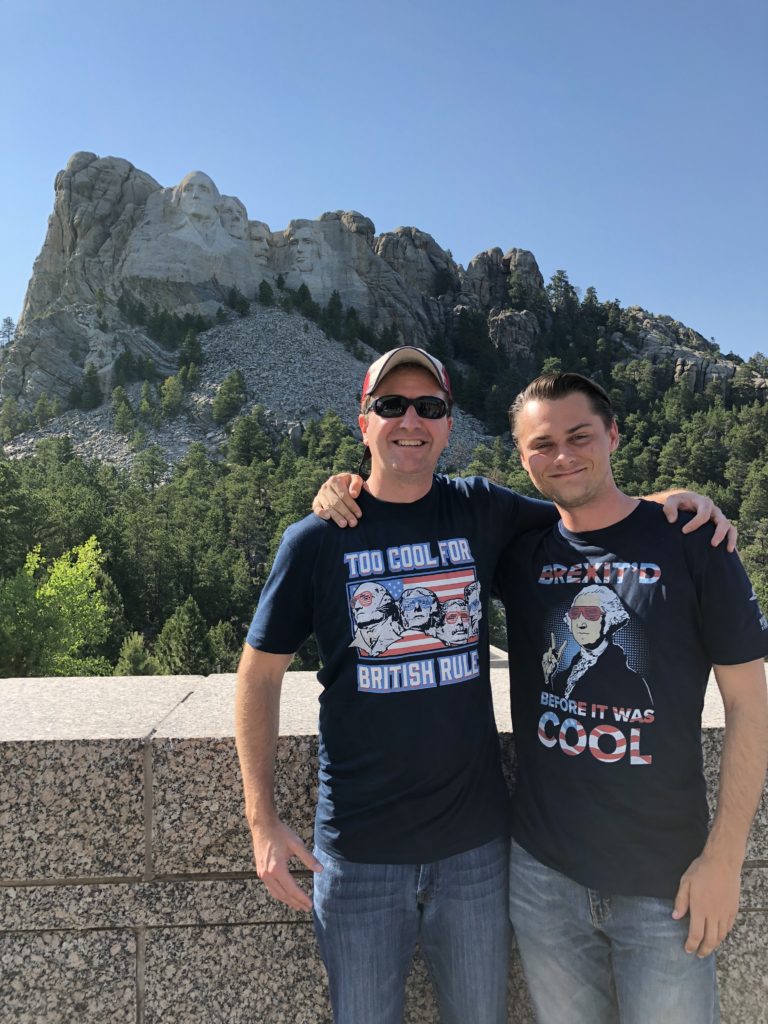 We went onto the grounds and I was just in awe. There it was. Mount Rushmore. George Washington, Thomas Jefferson, Teddy Roosevelt, and Abraham Lincoln. Four great Presidents. The sculptor Gutzon Borglum said he chose each of these Presidents to represent different aspects of our nation: Washington represents the founding and independence of our nation, Jefferson the opening of the West, Lincoln the unifier during our country’s biggest trial, and Roosevelt expanded us to a world power.
We went onto the grounds and I was just in awe. There it was. Mount Rushmore. George Washington, Thomas Jefferson, Teddy Roosevelt, and Abraham Lincoln. Four great Presidents. The sculptor Gutzon Borglum said he chose each of these Presidents to represent different aspects of our nation: Washington represents the founding and independence of our nation, Jefferson the opening of the West, Lincoln the unifier during our country’s biggest trial, and Roosevelt expanded us to a world power.
One interesting thing is that the person who first had the idea for a sculpture on this mountain did not envision any Presidents. They first thought it would be great to sculpt four western heroes. However, once Gutzon Borglum was selected, he thought that this project would be so monumental that it should depict figures that the entire nation would appreciate. And so, he chose these four Presidents for the reasons above. The South Dakota Chamber of Commerce remains thankful.
We walked through an indoor exhibit that tells the story of the monument. So many fascinating facts. There were photos and videos that showed what that mountain looked like before the sculpting. Then they showed us how it was done. I learned that 90% of the sculpture was created by dynamite blasts. They knew what amount of dynamite to do in each spot and just blasted the rocks away. It was fun watching video of this. They then finished and smoothed it off with other tools. No men died making it. And it took them 14 years to do so.
 The project began in 1927, with a commemoration ceremony that included President Calvin Coolidge. About 85% of the monument’s funding came from the federal government, while other funding was provided by private citizens, including schoolchildren in the area that gave up their allowance and milk money to contribute. Of course, most of this was completed throughout the Great Depression, so there was time when money dried up and the work slowed up. But under President Franklin Roosevelt, the Civilian Conservation Corps was employed to help clear some land and trees and pave many of the paths around what would become a nice park. However, the sculptures were not created from the men who served in the CCC. The sculptors were hired separately and were highly skilled craftsmen, who did what I have to say, was a marvelous job.
The project began in 1927, with a commemoration ceremony that included President Calvin Coolidge. About 85% of the monument’s funding came from the federal government, while other funding was provided by private citizens, including schoolchildren in the area that gave up their allowance and milk money to contribute. Of course, most of this was completed throughout the Great Depression, so there was time when money dried up and the work slowed up. But under President Franklin Roosevelt, the Civilian Conservation Corps was employed to help clear some land and trees and pave many of the paths around what would become a nice park. However, the sculptures were not created from the men who served in the CCC. The sculptors were hired separately and were highly skilled craftsmen, who did what I have to say, was a marvelous job.
Some people have told me that either they or others they knew came to Mount Rushmore and were underwhelmed. It wasn’t as impressive as they thought. We spent about an hour there in the early afternoon and came back later that evening for another four hours, where we were able to be there for an Independence Day celebration (more on that below). I got to look at this monument from many angles, for many hours, especially during the Independence Day celebration that took place at the amphitheater just below it. I just kept looking at Mount Rushmore. And the more I looked at it, the more in awe I was.
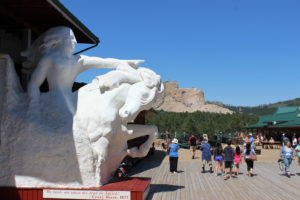 As I said to Marshall, “I don’t know how anyone can be underwhelmed by this magnificent sculpture.” In fact, I think it’s the most impressive sculpture I’ve ever seen and I have to think it’s one of the most impressive in all of the world. How did they do that? And how did they make the faces look so real and authentic?
As I said to Marshall, “I don’t know how anyone can be underwhelmed by this magnificent sculpture.” In fact, I think it’s the most impressive sculpture I’ve ever seen and I have to think it’s one of the most impressive in all of the world. How did they do that? And how did they make the faces look so real and authentic?
“The eyes,” I said to Marshall. “The eyes make them look so real.” One of the videos I watched in the visitor’s center had President George H.W. Bush say to the audience, when he was here to celebrate the monument’s 50th anniversary in 1991, that when you look at the faces of these great American leaders, you don’t just look at them, you see them looking back at you. Indeed, you do.
I also think they are looking out across the country, across the vast amount of land in the Dakotas and beyond. They are keeping a watchful eye on our nation and when we look up at them, it reminds us what ideals they gave us and what vision they had for us and they are looking at us reminding us to hold steady to their ideals and their vision – to ensure that liberty continues to shine throughout the land.
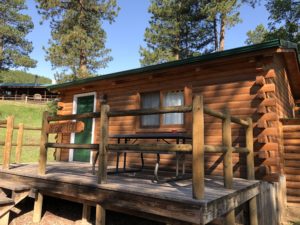 We had lunch in the big dining area that is part of the Mount Rushmore site. We met people from many different parts: Indiana, Alabama, Texas, and other places. Some of the people we met were going to other national parks, like Yellowstone in nearby Wyoming, as part of their vacation week. Others, rode motorcycles up from as far as Alabama and Texas. This is a great place to meet Americans from all over the country who come here to see some of their greatest leaders sculpted on the side of a mountain – and all during America’s independence week.
We had lunch in the big dining area that is part of the Mount Rushmore site. We met people from many different parts: Indiana, Alabama, Texas, and other places. Some of the people we met were going to other national parks, like Yellowstone in nearby Wyoming, as part of their vacation week. Others, rode motorcycles up from as far as Alabama and Texas. This is a great place to meet Americans from all over the country who come here to see some of their greatest leaders sculpted on the side of a mountain – and all during America’s independence week.
After we had lunch, we ventured about 30 minutes down the road to the Crazy Horse memorial. This memorial is still in process and honors one of the great Indian chiefs from this area. When completed, it will fully depict both his head and his horse. Unlike Mount Rushmore, it is being created without any taxpayer dollars. Private donations as well as the funds from visitor entrance fees (like the one we paid today) is what’s funding this monumental project (see what I did there?). This project has been decades in the making and they are not sure if it will even be completed in my lifetime.
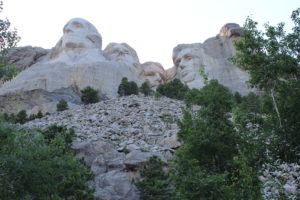 This monument, when finished, will be about five times the size of Mount Rushmore. Before I got here, some people told me not to go to Crazy Horse before I went to Mount Rushmore because Crazy Horse would be much more impressive and Mount Rushmore will be a letdown. While I followed this advice, I wasn’t as impressed with the Crazy Horse monument as I was with Mount Rushmore. I think maybe when it’s completed I could be more impressed, but it’s just not there yet.
This monument, when finished, will be about five times the size of Mount Rushmore. Before I got here, some people told me not to go to Crazy Horse before I went to Mount Rushmore because Crazy Horse would be much more impressive and Mount Rushmore will be a letdown. While I followed this advice, I wasn’t as impressed with the Crazy Horse monument as I was with Mount Rushmore. I think maybe when it’s completed I could be more impressed, but it’s just not there yet.
We paid the parking fee to get in. I think it was about $10 as well. And then we paid the extra $4 per person to take a short 5-minute bus ride to get a better look at the monument. Those extra few bucks were totally worth it. I took some great photos and I even zoomed in with my long lens to see some of the drilling going on up there. After reading about the creation of Mount Rushmore back in the 1920s and 1930s, I thought how cool is it that we’re here to see this one still being made. I said to Marshall, “Maybe one day, we can show our grandkids these pictures that we were here when this was being made.” Who knows when it will be completed.
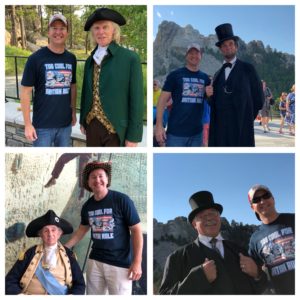 We went back into the visitor’s center quickly and saw a ton of Native American art and artifacts. From there, we drove the 30 minutes back to Keystone and checked into the Holy Smoke Lodge where we would be staying for two nights. This is a campground that is just 5 minutes away from what Marshall described as “The I-Drive of Keystone,” which is a lot of chain hotels, tourist traps, and souvenir shops. Some people camp out in tents at the Holy Smoke Resort, others bring their RV. For us, we rented a cabin for two nights. Inside, it had all the amenities of a hotel room, but all inside a log cabin. Pretty cool. After taking a quick rest there, we then headed back to Mount Rushmore, arriving there around 4:30pm and staying until almost 9pm.
We went back into the visitor’s center quickly and saw a ton of Native American art and artifacts. From there, we drove the 30 minutes back to Keystone and checked into the Holy Smoke Lodge where we would be staying for two nights. This is a campground that is just 5 minutes away from what Marshall described as “The I-Drive of Keystone,” which is a lot of chain hotels, tourist traps, and souvenir shops. Some people camp out in tents at the Holy Smoke Resort, others bring their RV. For us, we rented a cabin for two nights. Inside, it had all the amenities of a hotel room, but all inside a log cabin. Pretty cool. After taking a quick rest there, we then headed back to Mount Rushmore, arriving there around 4:30pm and staying until almost 9pm.
We hiked around the base of the mountain to get some different looks at the President’s heads. Then, we came back to the main areas and got to meet four reenactors, depicting the Presidents. Washington was a bit relaxed, pretty quiet, and somewhat humble. He wasn’t sure his face needed to be on the side of a mountain. Teddy Roosevelt was quite gregarious and very pleased to meet us. Lincoln seemed stoic and somber at the same time. He was also quite tall!
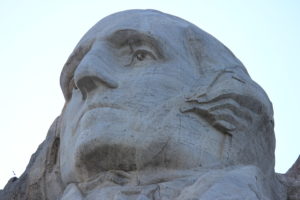 And Jefferson went on and on about history. Every time someone came up to him to take a photo and asked him a brief question, the answers were anything but brief. I heard one guy in line behind me tell his kid, “Don’t ask Mr. Jefferson any questions.” I chuckled.
And Jefferson went on and on about history. Every time someone came up to him to take a photo and asked him a brief question, the answers were anything but brief. I heard one guy in line behind me tell his kid, “Don’t ask Mr. Jefferson any questions.” I chuckled.
When I met President Jefferson, he asked me where I was from. “Florida,” I said. “Which Florida? East Florida or West Florida?” I told him East Florida. He said President Monroe was working on getting that to be part of the United States. Good idea, I thought.
The ceremony in the amphitheater below the base of Mount Rushmore started at 6:30pm and was a special Independence Day celebration. They haven’t done fireworks here since 2008 – due to fire hazards in the area. So there wouldn’t be any tonight. But every night of the summer months, they end the evening by the crowd singing the national anthem and the faces of the monument being lighted. Tonight, they did that as well.
But before we got to that, we were able to experience a few hours of songs and ceremony: they inducted a few dozen Air Force cadets into the service, as well as a few dozen “youth rangers” as part of some kind of park ranger program. The U.S. Air Force’s Heartland of America Band played many tunes throughout the evening. We were interrupted around 7:30pm for about 30 minutes or so due to a brief, yet massive thunderstorm that came through the area. We all ducked into the visitor’s center to wait it out. Then, the program resumed again.
 The final part of the evening where we sang God Bless America as well as the Star-Spangled Banner was just amazing. I kept looking up at the monument, just so impressed, filled with such patriotic pride in America and all of our nation’s ideals and accomplishments, including the sculpting of this monument. Marshall must have gotten tired of me saying things about it. “This is so cool,” I kept saying over and over. What an amazing day to be here on. As we left Mount Rushmore, I told Marshall, “There are few more patriotic people I could experience this site with, so thank you for coming.” He said the feeling was mutual.
The final part of the evening where we sang God Bless America as well as the Star-Spangled Banner was just amazing. I kept looking up at the monument, just so impressed, filled with such patriotic pride in America and all of our nation’s ideals and accomplishments, including the sculpting of this monument. Marshall must have gotten tired of me saying things about it. “This is so cool,” I kept saying over and over. What an amazing day to be here on. As we left Mount Rushmore, I told Marshall, “There are few more patriotic people I could experience this site with, so thank you for coming.” He said the feeling was mutual.
We got back to downtown Keystone just before 9pm and had a tremendous meal at Ruby’s. We both ordered the Buffalo ribs, which came with some salad and other sides. Yum. While there, another massive thunderstorm rolled through. This one lasted many hours. Hard rain and hail. We were luckily not parked far away and were just a 5-minute drive back to our log cabin.
We were able to call it a night and listen to the hard rain hitting the log cabin as we dreamed of many more years of independence for this great nation. As the clock rolled over to the Fourth of July, we had more festivities to partake in around the Black Hills of South Dakota.
